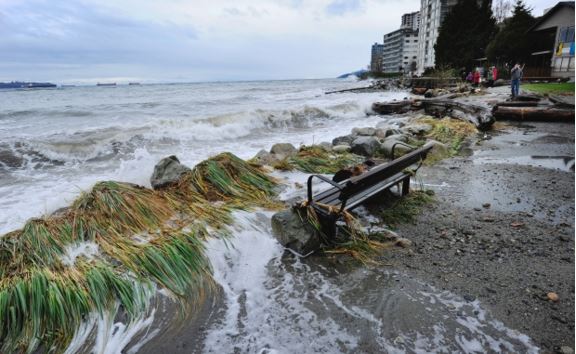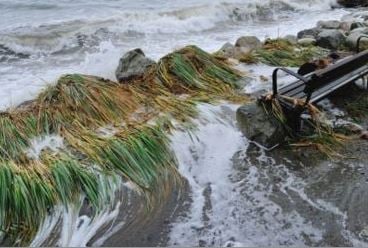Tens of thousands of sandbags have been used to create defensive barriers along a 200-metre stretch of Locarno Beach, one of the beaches that line English Bay in Vancouver, to protect low-lying homes from possible flooding due to high king tides starting this week.
‘King tide’ is a lay term for a very high tide, such as a perigean spring tide. It is not a scientific term and is never used in scientific texts. The term originated in New Zealand, Australia and other Pacific nations to refer to exceptionally high tides that occur a few times a year. The term ‘King Tide’ has become commonly used in the United States and British Columbia.
King tides occur when the gravitational forces of the Sun, Moon and Earth’s rotation combine, resulting in more water movement.
 A king tide pushing through at West Vancouver’s Ambleside Beach, in 2012.
A king tide pushing through at West Vancouver’s Ambleside Beach, in 2012.
A perigean tide
Every two weeks, the Sun and Moon align on the same side of Earth and produce gravitational forces that cause tides that are approximately 20% higher than normal. This is known as a spring tide – even though it has nothing to do with the spring season.
Three to four times each year, the Moon is at its closest approach to Earth – this is called a perigean tide.
The 2-foot high sandbag barriers will hopefully stop the water from coming through, as they did last year in Stanley Park, English Bay and False Creek.
The high tide this winter is forecast to reach a peak height of 4.9 metres (16 feet), and will hit from November 27th to 29th.
Local authorities said the sandbags will stay where they are until the beginning of next year.
After a 5.5 metre high (18 feet) king tide flooded the Locarno Beach area in 2012, sandbagging has become an annual event. In 2012, ocean waters flooded the beach and the Park Board’s concession stand building, and nearly spilled over onto the road.
If a storm and king tide coincide
CTV News quoted Brian Crowe, Vancouver’s director of water, sewers and district energy, who insisted that the King Tides should only pose a threat if they strike at the same time as a major storm. “What we’re preparing for here is the possibility of king tides coinciding with severe weather,” Crowe said.
Regarding the sandbags, Mr. Crowe added:
“There’s a fair likelihood that it won’t be needed. But given the length of sidewalk area here that we’ve sandbagged, you can imagine it wouldn’t be practical to run out here in the middle of a storm and try to do it, so the city’s acting proactively.”
Similar preventive measures are being carried out in nearby municipalities, including West Vancouver and Delta. In recent years, the two areas have suffered flooding.
There is talk in the local press about a long-term solution being built in 2016, including a dike – the gravel path by the beach would be raised, as would the sidewalk along the road.
If you live in the area and witness any flooding, you should telephone 311, authorities say.
Climate scientists warn that global warming will make matters worse for the coastal low-lying areas of British Columbia. They urge the authorities to start preparing for more severe annual floods.
Video – King tide at Qualicum Beach
This video shows the king tide in 2014 at Qualicum Beach, a town located on Vancouver Island.

